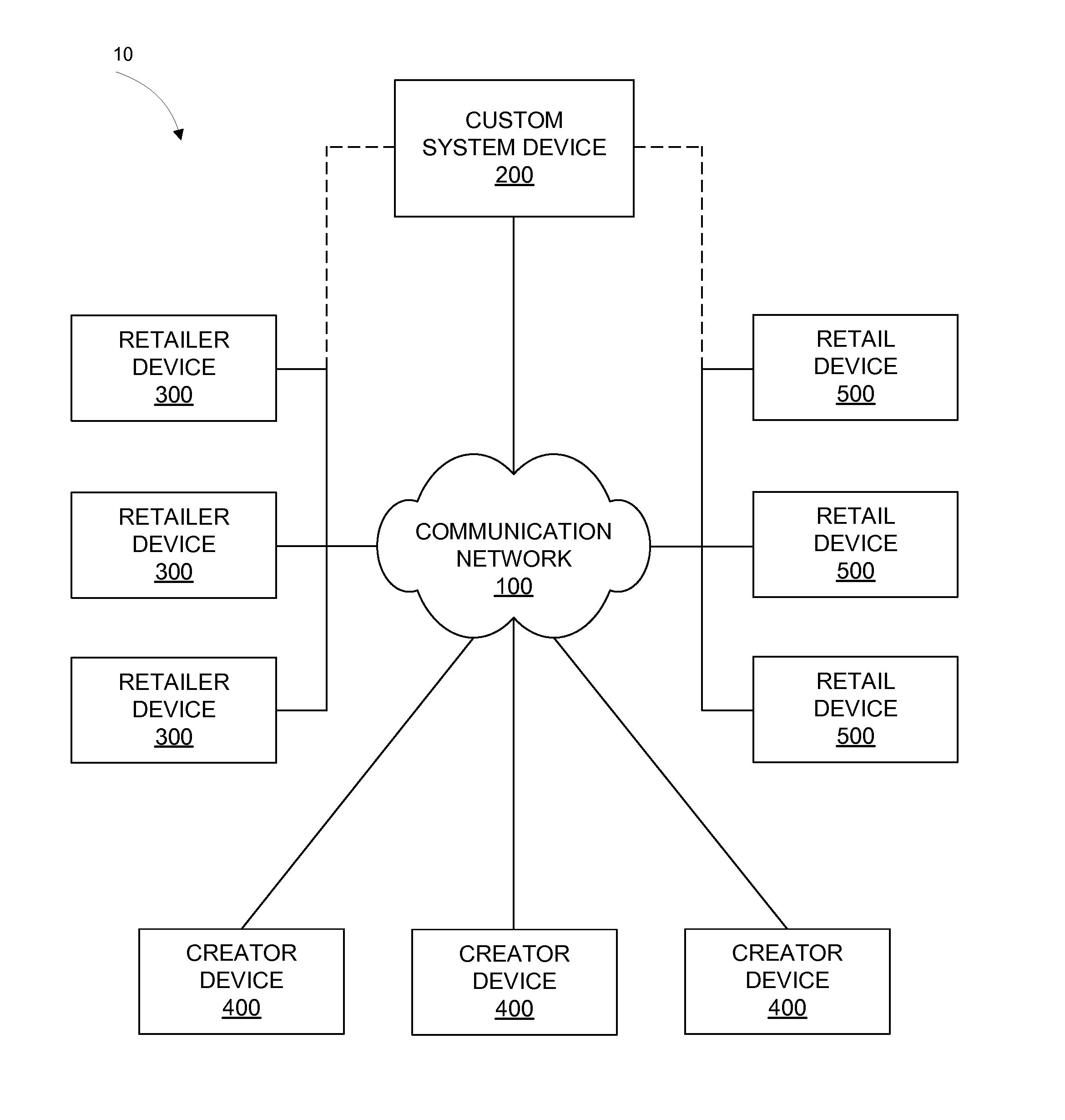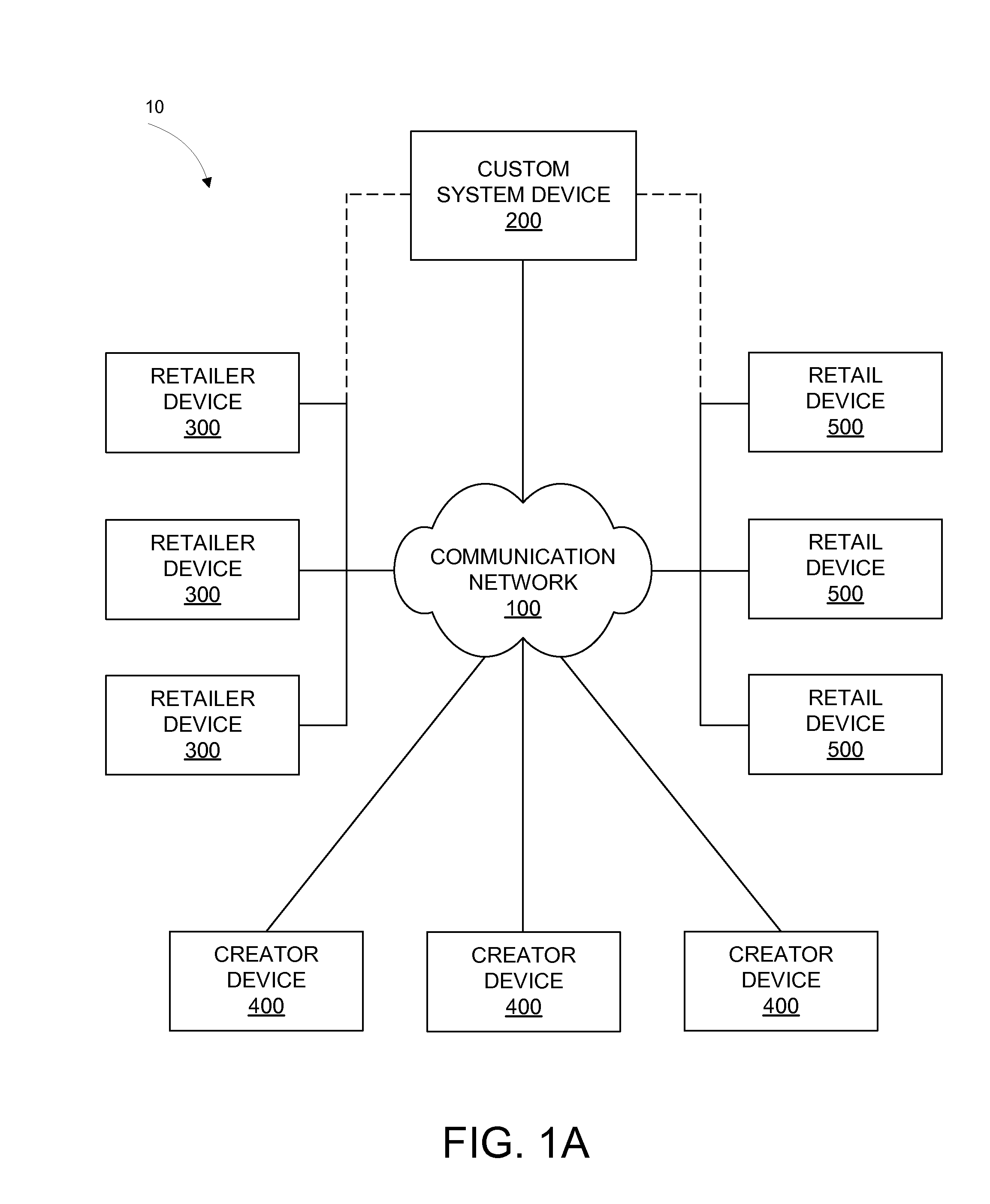[0028] An aspect of the present invention is to allow system users such as a consumer to define products over a communications network (e.g.,
the Internet) by causing the customization of both the
product identifier and the
product description elements of a product. A related aspect of the latter element is allowing participating retailers to
expose their inventory of manufacturing processes and materials usually available at selected retail location(s) so as to allow their use in the definition of customized products via a communications network. A related aspect of the present invention is to allow participating retailers or other entities to determine the rules and degree of freedom according to which both elements may be customized in a product that can be ordered at one or more retail location(s) where the product may be identified and sold by participating retailers or other retailers. A related aspect of the present invention is to allow consumers to both independently define a product through the system, as creator users, and thereafter place order(s) for such product at selected retail location(s), as consumers. A related aspect of the present invention is to allow consumers other than the product's original creator to place orders for said product. A related aspect of the present invention is to allow for a, near real time, menu display of creator-users-defined products for product
information access and
product order selection by consumers at retail location(s) located virtually anywhere and associated with any number of retailers.
[0029] Another aspect of the present invention is to allow the placement of repeated orders for a product, defined online by a creator user such as a consumer, by a consumer's singular communication of a valid
product identifier to a selected retail operator. A related aspect of this invention is to allow retail location(s) the singular input of a valid product identifier to a system for retrieval, potentially in real time with its customization, of sufficient standardized information to allow the frequent identification, manufacture and sale of a product maybe never before provided by said retailer(s). A related aspect of the present invention is to allow selected retailers to identify, manufacture and sell, previously unknown and never before manufactured product(s), upon communication by consumer of a singular customized product identifier.
[0030] Another aspect of the present invention is to allow system users such as retailers and consumers to benefit from the timesaving and error-proofing advantages of the present invention. For example, without limitation, complex food orders, such as, but not limited to, a
meal for large numbers of people or a highly customized product, can be ordered by a consumer's singular communication of a product identifier to a retailer. Another aspect is that the placement of a potentially complex food order with a customized product identifier may benefit many system users in different ways. For example, without limitation, speech impaired individuals may benefit greatly from the ability to use faster and simpler communication, verbal or automated.
[0031] Another aspect of the present invention is to allow retailers to keep a
record of individual, or group,
user information including consumer preferences as to preparation of
food products readily accessible in real time from a virtually unlimited number of retail location(s) connected to a communication network. A related aspect of this invention is to allow the accurate and consistent recording and costing of customized consumer preferences by retailers. Another aspect of the present invention is to allow the development of new possibilities for business-consumer communication and marketing. For instance, without limitation, the desire to create customized recipes and meals can drive users to a Website online, therefore, allowing retailers to
expose more potential consumers to their offerings, with dynamic and potentially user-customized Web experiences, and creating opportunities for retailers to increase their market knowledge and customer preferences. An aspect of some embodiments may be a potential user registration process that could allow for the collection of further data, and the further development of customized marketing relationships with potential customers. Moreover, the possibility for and ease of customization and the convenience of customized product order placement allowed by particular embodiments of the present invention can increase consumer loyalty and overall satisfaction. A related aspect of the present invention is to allow system users to have access to increased education regarding retailer offerings. For example, without limitation, virtually unlimited
virtual space can be made available online to convey up to date real
time information to educate users about offerings and related information, such as nutritional or user
health related information. A potential user registration may further the collection of user data regarding, for instance, without limitation, user's
medical history and to
cross reference such information with retailer information stored in the system to, for instance, without limitation, warn a diabetic user of a product's
sugar(s) type(s) and amount(s).
[0032] A further aspect of the present invention is to allow retailers such as participating retailers, and others, the potential value and business benefits that can be derived from tapping into the creative power of consumers and other entities interested in the independent definition of products that can thereafter be made available by said, or other independent retailers at selected retail location(s). A related aspect of this invention is to allow the potential creation of markets such as, for example, without limitation, where creator users may exchange product definitions for a value, or be rewarded with something of value, for example, for sales volume or other aspects of each of their product's use through the system; or where retailers, participating or independent, may be granted access to selected
system information and functionality, for example, as retail users, freely or with consideration given for value. A further aspect of this invention is to allow the application of further product manufacture and / or sale
automation systems, both of which are herein facilitated by the participating retailer(s)' usually available manufacturing resources and
inventory data set(s)
standardization, normalization, and modeling into information stored in a
relational database server system so as to permit further systems integration with available retailer(s)' standard
point of sale systems and automated
manufacturing systems, to further increase the time-saving, error-proofing and other useful aspects of present invention.
 Login to View More
Login to View More  Login to View More
Login to View More 


